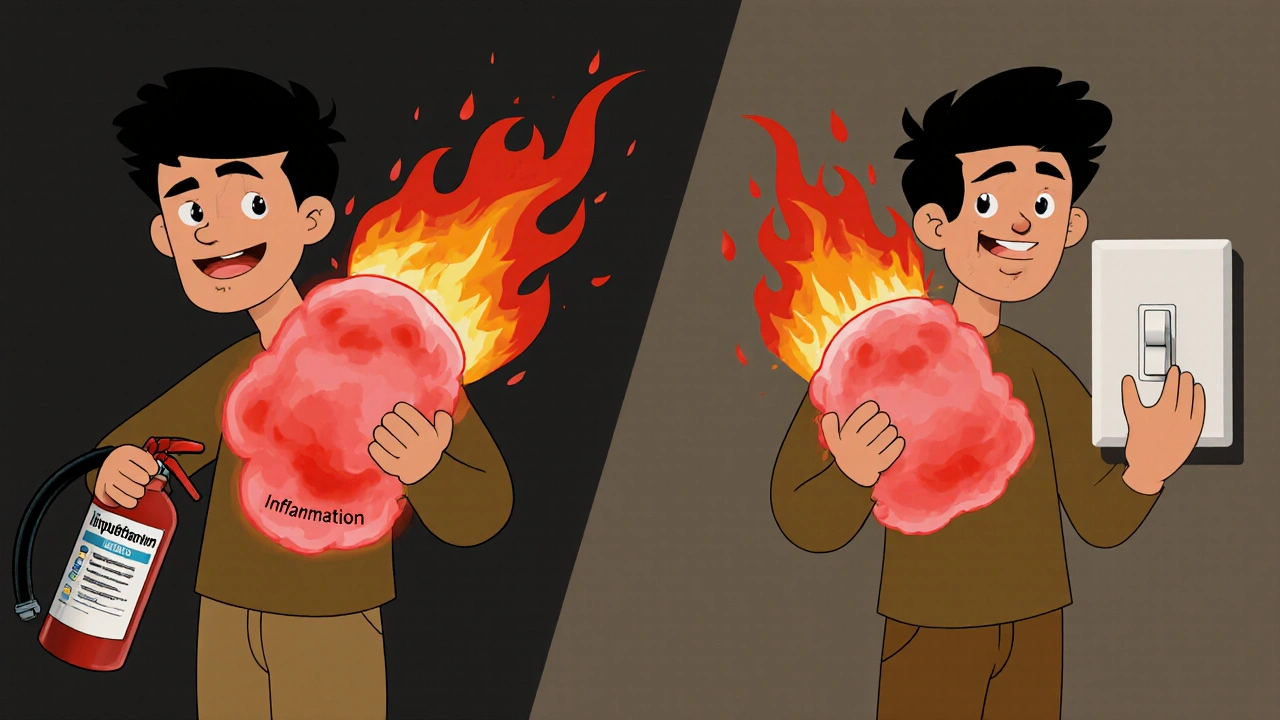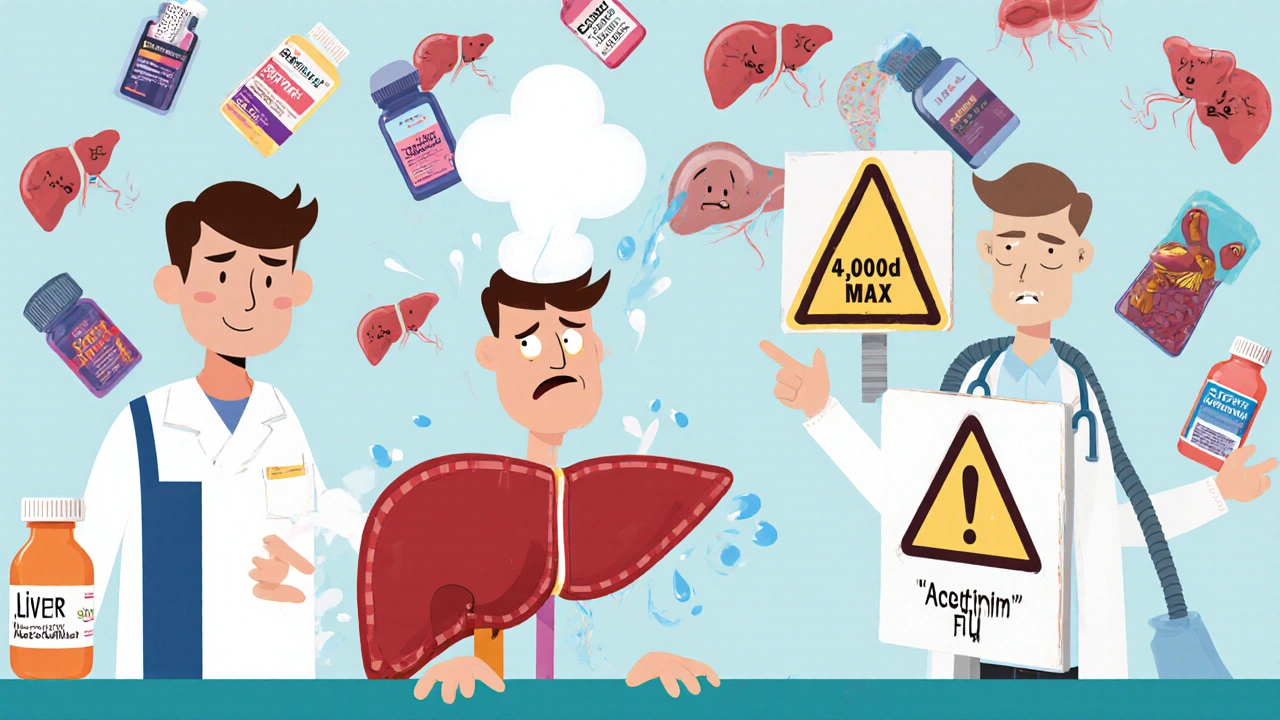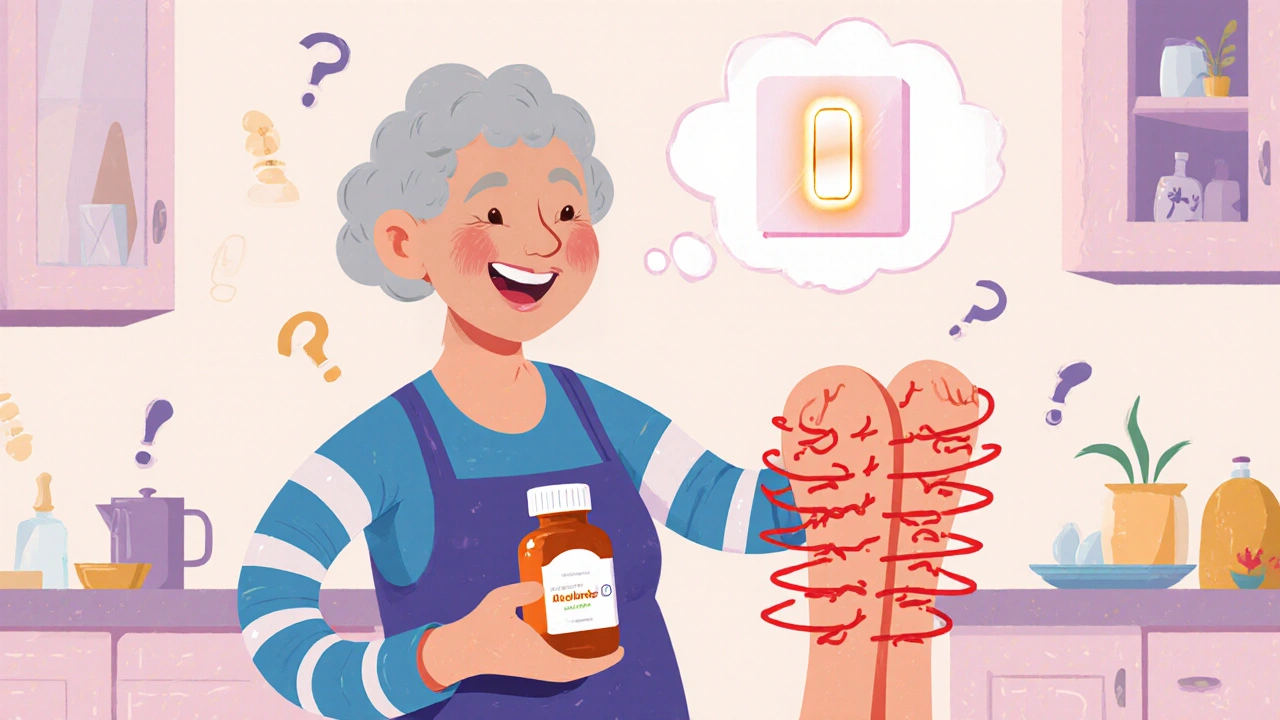If you’ve been dealing with sore, aching legs - maybe from standing all day, overdoing it at the gym, or just aging - you’ve probably reached for acetaminophen. It’s in almost every medicine cabinet. But does it actually help with leg pain? Or are you just wasting pills and money?
What acetaminophen actually does
Acetaminophen, also known as paracetamol in many countries, isn’t an anti-inflammatory. That’s the big difference between it and ibuprofen or naproxen. It doesn’t reduce swelling. It doesn’t calm redness or heat in a joint. What it does is block pain signals in your brain. It’s a quiet, steady pain reliever - not a fire extinguisher, but a dimmer switch.
For leg pain caused by muscle strain, mild arthritis, or even just general soreness after walking too far, acetaminophen can make a noticeable difference. A 2023 review in the British Journal of Clinical Pharmacology found that acetaminophen was as effective as low-dose NSAIDs for musculoskeletal pain in older adults - without the stomach or kidney risks.
But here’s the catch: if your leg pain comes from inflammation - like tendonitis, bursitis, or a flare-up of osteoarthritis - acetaminophen might not cut it. You’ll feel better, sure, but not because the root cause changed. You’re just not feeling it as much.
When acetaminophen works for leg pain
Here are the most common situations where acetaminophen actually helps with leg pain:
- Mild muscle soreness after a long walk, hike, or new workout routine
- Generalized leg aches from standing on concrete all day, especially if you’re on your feet for work
- Early-stage osteoarthritis in the knees or hips, where swelling isn’t severe
- Nerve-related discomfort like mild sciatica or diabetic neuropathy - though results vary
- Post-surgical pain after minor leg procedures, when doctors recommend avoiding NSAIDs
One real-world example: Sarah, 62, from Cambridge, started having dull, constant aches in both thighs after retiring and walking less. Her GP suggested acetaminophen 500 mg every 6 hours as needed. Within three days, she said the background ache dropped from a 6/10 to a 2/10. She didn’t get stronger - but she didn’t feel it as much, and that was enough to let her move more comfortably.
When acetaminophen doesn’t help
Leg pain isn’t one thing. And acetaminophen won’t fix everything.
If you have:
- Swelling, warmth, or redness in your calf or knee - that’s inflammation. Try ibuprofen instead.
- Sudden, sharp pain in the calf - could be a blood clot. Don’t wait for a pill to work. Go to urgent care.
- Numbness or tingling down the leg - nerve compression like a pinched sciatic nerve. Painkillers won’t fix the root issue.
- Pain that wakes you up at night - especially if it’s worse when lying down. Could be something like spinal stenosis or even a tumor. Acetaminophen won’t mask this long-term.
- Pain after trauma - like a fall or direct hit. If it’s broken or torn, you need imaging, not pills.
One study from the University of Oxford tracked 400 people with chronic leg pain over six months. Those with inflammatory causes (like rheumatoid arthritis or gout) saw only 18% pain reduction with acetaminophen. Those with non-inflammatory causes (like muscle fatigue or mild osteoarthritis) saw 47% improvement. The difference wasn’t small - it was decisive.

Dosage and safety
Most over-the-counter acetaminophen comes in 500 mg tablets. The standard adult dose is one to two tablets every 4 to 6 hours. Never exceed 4,000 mg in 24 hours. That’s eight 500 mg pills. Many people don’t realize how easy it is to accidentally overdose.
Here’s where it gets dangerous: you’re probably taking it without knowing. Cold medicines, flu remedies, and even some sleep aids contain acetaminophen. If you take one for your headache and another for your leg pain, you could hit the limit without realizing it.
Liver damage from acetaminophen is the #1 cause of acute liver failure in the UK and US. It doesn’t happen from one bad day - it builds up. People think, “I’m just taking a few pills,” but if you’re drinking alcohol regularly, even a little, your liver’s tolerance drops fast.
Rule of thumb: if you drink more than one alcoholic drink a day, don’t take more than 2,000 mg of acetaminophen daily. And if you’re over 65, your liver processes it slower. Talk to your pharmacist before starting.
Alternatives to acetaminophen for leg pain
If acetaminophen isn’t working, or you’re worried about liver safety, here are other options:
- Ibuprofen or naproxen - better for swelling, joint pain, or inflammation-related leg pain. Avoid if you have kidney issues or stomach ulcers.
- Topical creams - menthol, capsaicin, or diclofenac gel applied directly to the leg. Fewer systemic side effects.
- Physical therapy - for chronic pain, strengthening weak muscles and improving movement patterns cuts pain better than any pill.
- Compression socks - if your legs ache from poor circulation or standing, these help more than you’d think.
- Heat or ice - ice for recent injury, heat for stiff, aching muscles.
Some people swear by magnesium supplements for nighttime leg cramps. The evidence is mixed, but it’s low-risk. Worth a try if you get cramps often.

When to see a doctor
Don’t wait for pain to get worse. See a GP if:
- Pain lasts more than two weeks despite rest and OTC meds
- You notice weakness, numbness, or loss of balance
- Legs feel cold or change color
- Pain comes with fever, unexplained weight loss, or night sweats
- You’re taking acetaminophen daily for more than 10 days straight
Leg pain can be a symptom of something deeper - peripheral artery disease, spinal issues, even diabetes complications. A simple blood test or ultrasound can rule out serious causes. Don’t assume it’s just "old age" or "overuse."
Realistic expectations
Acetaminophen isn’t magic. It won’t heal your joints. It won’t fix your posture. It won’t make you stronger. What it can do is give you a few hours of relief so you can move, stretch, or sleep - and that’s not nothing.
Think of it like a bandage on a cut. It doesn’t heal the wound, but it lets you go about your day without constant distraction. For many people with mild leg pain, that’s enough.
But if you’re relying on it every day, you’re treating the symptom, not the cause. And that’s where real help begins - with movement, rest, proper footwear, and sometimes, professional care.
Can acetaminophen help with leg cramps at night?
It might help reduce the pain after a cramp, but it won’t stop cramps from happening. Nighttime leg cramps are often linked to dehydration, low magnesium, or nerve issues. Stretching before bed, drinking enough water, and trying a magnesium supplement are more effective long-term solutions.
Is acetaminophen safer than ibuprofen for leg pain?
It depends. Acetaminophen is safer for your stomach and kidneys, but riskier for your liver - especially if you drink alcohol or take it daily. Ibuprofen is better for inflammation-related pain but can cause ulcers or raise blood pressure. If you have no liver issues and no stomach problems, either can work. Choose based on your health history.
How long does acetaminophen take to work for leg pain?
You should start feeling relief within 30 to 45 minutes after taking it orally. Peak effect is around 1 to 2 hours. If you don’t feel any change after 2 hours, it’s unlikely to help - the pain probably isn’t from the kind of signals acetaminophen blocks.
Can I take acetaminophen every day for chronic leg pain?
Not without medical supervision. Daily use for more than 10 days increases liver risk, even at normal doses. Chronic pain needs a plan - physical therapy, weight management, or addressing the root cause. Relying on pills long-term is a band-aid that can cause bigger problems.
Does acetaminophen help with sciatica?
Sometimes, but not reliably. Sciatica is nerve pain, and acetaminophen works best on general aches and muscle pain. Some people get mild relief, but others feel almost nothing. Physical therapy, nerve glides, and posture correction are more effective for sciatica than any painkiller.
 Oct, 19 2025
Oct, 19 2025
